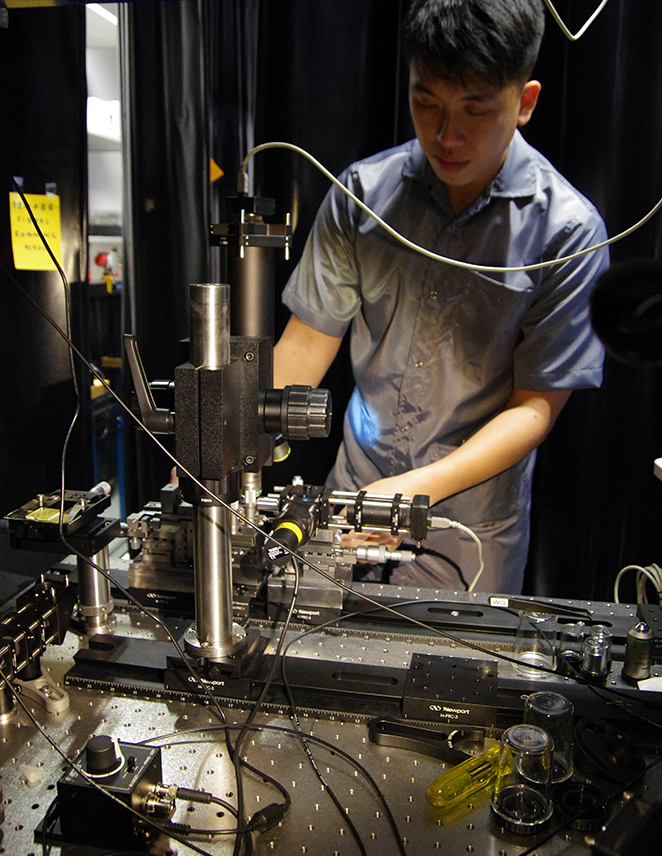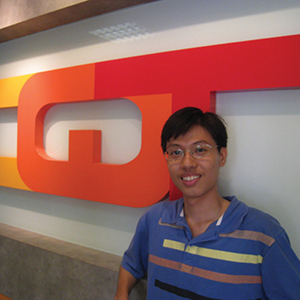Highlights
Undergrad researcher at CQT filmed for TV documentary

NUS physics student Ng Kian Fong who is doing a research project at CQT was filmed for a documentary "Invented in Singapore: A Dynamic Education" shown on Channel News Asia.
The Undergraduate Research Opportunities in Science (UROPS) scheme at the National University of Singapore exists for students to "experience the challenges and benefits that come from pursuing an independent research project". Students sign up for projects with University faculty for one or two semesters. CQT Principal Investigators have supervised over 60 such undergraduate projects since the Centre started, seeing a few of these students win University prizes for their work. But third-year physics undergraduate Ng Kian Fong, who is working on a UROPS project in the group of Alexander Ling, is the first to be seen on TV.
Kian Fong was filmed for a documentary screened by Channel News Asia on 19 February 2016 called "Invented in Singapore: A Dynamic Education". Produced by Mediacorp in collaboration with NUS, the documentary celebrates the science and technology achievements of Singapore's Institutes of Higher Learning. The first episode describes how Singapore's dynamic science and engineering education helps young people fulfil their dreams and create innovations that impact lives. This episode briefly shows Kian Fong and a fellow UROPS student discussing their projects in CQT's quantum cafe. The second episode shows how university and polytechnic researchers are transforming Singapore to create a sustainable future.
"Invented in Singapore: A Dynamic Education" was produced by Mediacorp in collaboration with NUS. Watch the trailer here.
We asked Kian Fong a few questions about his experience:
How did you feel about being part of the documentary?
Kian Fong:I was very nervous because it was my first time going on TV. I prepared a script and tried to be concise, to make sure I don't miss out on what I wanted to say. You don't hear me talking in the final cut, but it's still an honour to have been filmed!
What is your UROPS project?
My project is about making a flexible waveguide platform that can be programmed via mechanical stretching. A waveguide is a structure that confines light, guiding the light in whatever direction we want. We are interested in what happens if we put two waveguides close together and we inject light through one of them. If the waveguides are very close together, the light can jump over very easily from one to the other. We try to change the distance between the waveguides to control how much light there is passing. The idea is to have an array of these waveguides, hundreds of them branching like a tree. You can imagine that you inject a photon at the start then you see where the photon eventually lands. This kind of device has applications in sensing, simulation and computation.
Have you managed to build a working device?
We are still at the stage of characterising the waveguide. I am doing a one-year project and have not finished yet. I am testing my first structure – it's a simple one where we can inject light in one end and see whether it comes out both ends. In the initial stage we have been building this beamsplitter ourselves, using a material called PDMS (Polydimethylsiloxane). It comes as a liquid and you cure it at a certain temperature to get the refractive index you want. Something I have learnt about research is that it's very time consuming. You have to repeat the same procedure over and over again to make sure you get the best results.
How has your experience of research been overall?
I am still new and I don't think I have done a lot in this research field yet. I think I have much more to learn and much more to see. But so far I would say it's fascinating. My postdoc James Grieve has been a good guide. He will talk me through stuff and then let me fiddle around on my own. At the end of the day, he makes sure that I get the right things done. When I first joined this project, I was uncertain about whether I would actually be interested in research work, but nevertheless I gave it a try and it turned out very well. I would encourage other undergraduates to give UROPS a try.
CQT projects for UROPS may be offered in physics and computer science. Students are also welcome to apply directly to PIs for internships.
Learn more
Related Stories
 | Undergraduate honoured with University prize for CQT project November 26 2013 |
 | CQT undergraduate research scoops University award for third consecutive year August 02 2011 |






